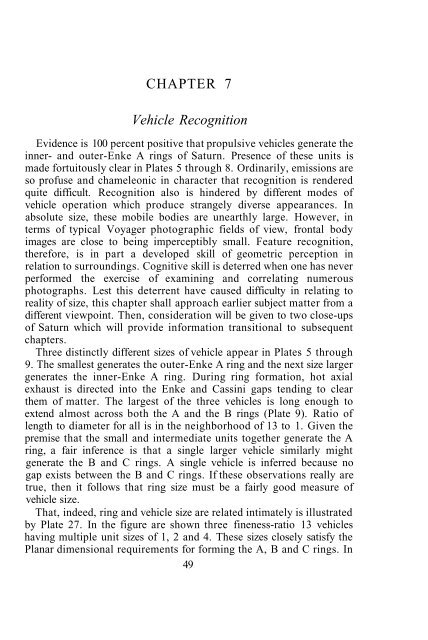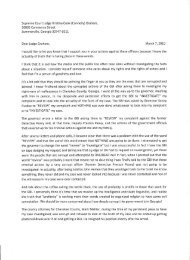Ringmakers of Saturn PDF - Patrick Crusade
Ringmakers of Saturn PDF - Patrick Crusade
Ringmakers of Saturn PDF - Patrick Crusade
You also want an ePaper? Increase the reach of your titles
YUMPU automatically turns print PDFs into web optimized ePapers that Google loves.
CHAPTER 7<br />
Vehicle Recognition<br />
Evidence is 100 percent positive that propulsive vehicles generate the<br />
inner- and outer-Enke A rings <strong>of</strong> <strong>Saturn</strong>. Presence <strong>of</strong> these units is<br />
made fortuitously clear in Plates 5 through 8. Ordinarily, emissions are<br />
so pr<strong>of</strong>use and chameleonic in character that recognition is rendered<br />
quite difficult. Recognition also is hindered by different modes <strong>of</strong><br />
vehicle operation which produce strangely diverse appearances. In<br />
absolute size, these mobile bodies are unearthly large. However, in<br />
terms <strong>of</strong> typical Voyager photographic fields <strong>of</strong> view, frontal body<br />
images are close to being imperceptibly small. Feature recognition,<br />
therefore, is in part a developed skill <strong>of</strong> geometric perception in<br />
relation to surroundings. Cognitive skill is deterred when one has never<br />
performed the exercise <strong>of</strong> examining and correlating numerous<br />
photographs. Lest this deterrent have caused difficulty in relating to<br />
reality <strong>of</strong> size, this chapter shall approach earlier subject matter from a<br />
different viewpoint. Then, consideration will be given to two close-ups<br />
<strong>of</strong> <strong>Saturn</strong> which will provide information transitional to subsequent<br />
chapters.<br />
Three distinctly different sizes <strong>of</strong> vehicle appear in Plates 5 through<br />
9. The smallest generates the outer-Enke A ring and the next size larger<br />
generates the inner-Enke A ring. During ring formation, hot axial<br />
exhaust is directed into the Enke and Cassini gaps tending to clear<br />
them <strong>of</strong> matter. The largest <strong>of</strong> the three vehicles is long enough to<br />
extend almost across both the A and the B rings (Plate 9). Ratio <strong>of</strong><br />
length to diameter for all is in the neighborhood <strong>of</strong> 13 to 1. Given the<br />
premise that the small and intermediate units together generate the A<br />
ring, a fair inference is that a single larger vehicle similarly might<br />
generate the B and C rings. A single vehicle is inferred because no<br />
gap exists between the B and C rings. If these observations really are<br />
true, then it follows that ring size must be a fairly good measure <strong>of</strong><br />
vehicle size.<br />
That, indeed, ring and vehicle size are related intimately is illustrated<br />
by Plate 27. In the figure are shown three fineness-ratio 13 vehicles<br />
having multiple unit sizes <strong>of</strong> 1, 2 and 4. These sizes closely satisfy the<br />
Planar dimensional requirements for forming the A, B and C rings. In<br />
49



